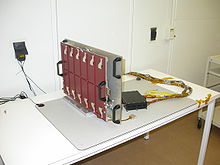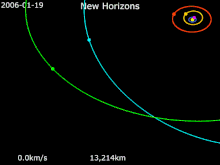


New Horizons · 486958 Arrokoth · Earth · 132524 APL · Jupiter · Pluto VBSDC can record micron size dust impacts on NH's route away from the Sun and past Pluto
The Venetia Burney Student Dust Counter (VBSDC) is a scientific instrument aboard the uncrewed New Horizons space probe that is designed to detect dust impacts in outer space.[1] VBSDC is the first planetary science instrument to be built by students.[2] The dust counter was launched in 2006, and named later that year after Venetia Burney, the young girl who originally named Pluto.[2] The detector works when dust strikes films of polarized polyvinylidene fluoride (PVDF), which generates an electrical charge.[3] The space dust is then detected over the course of the New Horizons spacecraft flight out of the Solar System and past Pluto.[3]
- ^ Poppe, Andrew; James, David; Jacobsmeyer, Brian; Horányi, Mihály (June 2010). "First results from the Venetia Burney Student Dust Counter on the New Horizons mission". Geophysical Research Letters. 37 (11): n/a. Bibcode:2010GeoRL..3711101P. doi:10.1029/2010gl043300. ISSN 0094-8276.
- ^ a b JHUAPL. "Student Dust Counter instrument breaks distance record". New Horizons. Retrieved 2018-10-13.
- ^ a b "THE STUDENT DUST COUNTER ON THE NEW HORIZONS MISSION" (PDF). SWRI. Retrieved November 12, 2022.